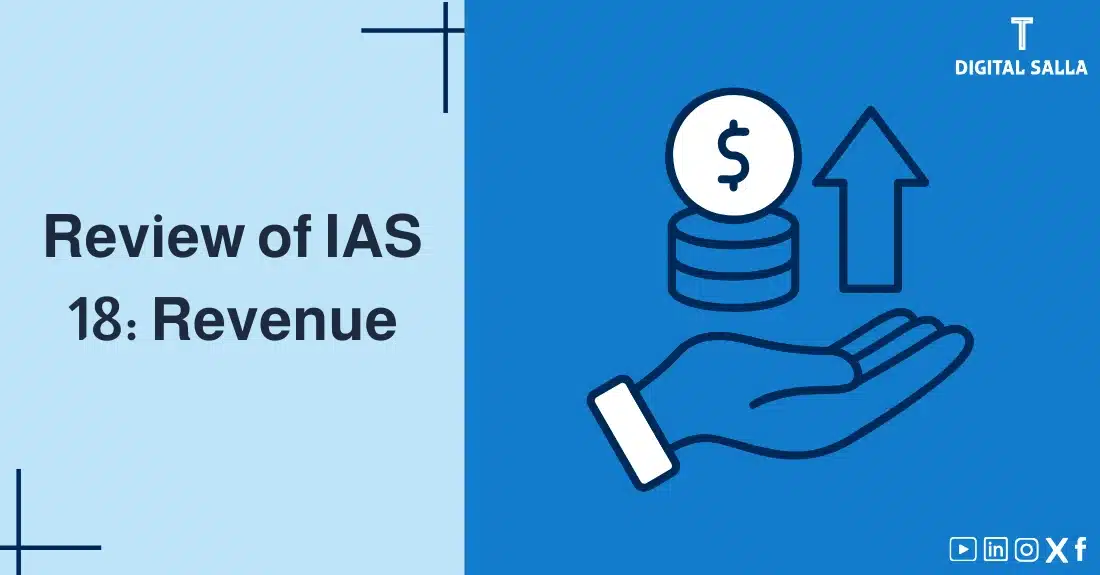Review of IAS 18 Standard: Revenue

IAS 18 Standard, “Revenue,” was the primary standard within the International Financial Reporting Standards (IFRS) that addressed how to recognize, measure, and present revenue in the financial statements, before it was superseded by IFRS 15, “Revenue from Contracts with Customers,” effective January 1, 2018.
Although IAS 18 Standard is no longer in effect, understanding it remains essential for analyzing companies’ financial statements for prior periods and for understanding the developments in revenue accounting. In this article, we will review IAS 18 Standard, discussing its objectives, scope, and key requirements, focusing on how to recognize revenue from the sale of goods, the rendering of services, and other activities, in addition to highlighting the importance of this standard (before its supersession) and its impact on the financial statements, and the key differences between it and the new IFRS 15.
What was IAS 18 Standard: Revenue?
IAS 18 Standard was an international accounting standard, now superseded, that specified how to recognize, measure, and present revenue in the financial statements. The standard aimed to ensure that revenue was recognized when the risks and rewards of ownership were substantially transferred to the buyer and when the revenue could be measured reliably.
Objectives of IAS 18 Standard:
- Determine When to Recognize Revenue: IAS 18 Standard provided guidance on the timing of revenue recognition from the sale of goods, the rendering of services, and other activities.
- Determine How to Measure Revenue: IAS 18 Standard specified how to measure recognized revenue, taking into account any discounts or returns.
- Improve the Quality of Disclosures: IAS 18 Standard imposed specific disclosure requirements aimed at improving the transparency and reliability of information related to revenue in the financial statements.
- Enhance Comparability: IAS 18 Standard contributed to improving the comparability of financial statements of companies by standardizing how revenue was recognized.
Scope of IAS 18 Standard:
IAS 18 Standard applied to accounting for revenue arising from the following transactions and events:
- Sale of goods: This included the sale of goods produced by the entity, as well as goods purchased for resale, such as merchandise sold by a retailer, or land and other property held for resale.
- Rendering of services: This included the rendering of services to customers, whether services continued over a period of time or were provided on a one-time basis.
- The use by others of entity assets yielding interest, royalties, and dividends: This included revenue arising from the use of the entity’s assets by external parties, such as interest on loans granted, royalties from the use of patents or trademarks, and dividends from investments in the shares of other companies.
IAS 18 Standard did not apply to:
- Lease agreements (IAS 17 Standard applied – now superseded).
- Insurance contracts (IFRS 4 applied – now superseded).
- Changes in the fair value of financial instruments (IAS 39 applied – now superseded).
- Changes in the value of biological assets (IAS 41 applied).
- The initial recognition of agricultural produce (IAS 41 applied).
- The extraction of mineral ores.
- Construction Contracts (IAS 11 Applied – Now superseded).
Revenue Recognition under IAS 18 Standard:
IAS 18 Standard specified certain conditions for revenue recognition that varied depending on the type of activity:
- Sale of Goods: Revenue from the sale of goods was recognized when all of the following conditions were met:
- The entity has transferred to the buyer the significant risks and rewards of ownership of the goods: This condition is the essence of revenue recognition, where control of the goods must be effectively transferred to the buyer.
- The entity retains neither continuing managerial involvement to the degree usually associated with ownership nor effective control over the goods sold: The entity must lose control over the goods sold and not participate in their management after the sale.
- The amount of revenue can be measured reliably: The amount of revenue must be measurable with sufficient reliability.
- It is probable that the economic benefits associated with the transaction will flow to the entity: It must be likely that the entity will receive the agreed-upon consideration for the goods sold.
- The costs incurred or to be incurred in respect of the transaction can be measured reliably: The costs of completing the sale must be measurable with reliability in order to be matched with revenues according to the matching principle.
- Retail Sales: Revenue is typically recognized at the point of sale, where control of the goods is transferred to the customer.
- Installment Sales: If the collection of the consideration is not reasonably assured, revenue recognition may be deferred until the payments are collected.
- Sales with Right of Return: If the buyer has the right to return the goods, the entity must estimate the value of expected returns and recognize revenue only after deducting this value.
- Rendering of Services: Revenue from the rendering of services was recognized by reference to the stage of completion at the reporting date, when the outcome of the transaction could be estimated reliably. The outcome was considered reliably estimable when all the following conditions were satisfied:
- The amount of revenue can be measured reliably.
- It is probable that the economic benefits associated with the transaction will flow to the entity.
- The stage of completion of the transaction at the end of the reporting period can be measured reliably.
- The costs incurred for the transaction and the costs to complete the transaction can be measured reliably.
- The proportion that costs incurred to date bear to the estimated total costs.
- Surveys of work performed.
- The proportion that services performed to date bear to the total services to be performed.
- Interest, Royalties, and Dividends:
- Interest: Recognized using the effective interest method (as defined in IAS 39 Standard – superseded).
- Royalties: Recognized on an accrual basis in accordance with the substance of the relevant agreement.
- Dividends: Recognized when the right to receive payment is established, i.e., when the distributing company declares the dividends.
Measurement of Revenue:
IAS 18 Standard required revenue to be measured at the fair value of the consideration received or receivable, taking into account any trade discounts and volume rebates allowed by the entity.
Disclosure Requirements under IAS 18 Standard:
IAS 18 Standard required entities to disclose the following information:
- The accounting policies adopted for the recognition of revenue.
- The amount of each significant category of revenue recognized during the period, including revenue arising from the sale of goods, the rendering of services, interest, royalties, and dividends.
- The amount of revenue arising from exchanges of goods or services included in each significant category of revenue.
Importance of IAS 18 Standard (Before its Supersession):
IAS 18 Standard was an important IFRS that helps companies to:
- Comply with IFRS: IAS 18 Standard specified how to recognize revenue according to IFRS.
- Improve the Quality of Financial Reporting: IAS 18 Standard contributed to improving the quality, relevance, and reliability of financial information related to revenue.
- Enhance Investor Confidence: IAS 18 Standard helped build investor confidence by providing more accurate and transparent information about how revenue was recognized.
Transition to IFRS 15:
IAS 18 Standard was superseded by IFRS 15, “Revenue from Contracts with Customers,” effective January 1, 2018. IFRS 15 provides a single, principles-based model for recognizing revenue from all types of contracts with customers, regardless of the industry or type of transaction.
Key Steps for Transitioning to IFRS 15:
- Understand the requirements of IFRS 15: Companies should carefully study IFRS 15 and understand its requirements comprehensively.
- Assess the impact of IFRS 15 on the company: Companies should assess the impact of applying IFRS 15 on their accounting policies, systems, and processes.
- Identify contracts with customers: Identify all contracts with customers that fall within the scope of IFRS 15.
- Apply IFRS 15 five-step model: The five steps for recognizing revenue according to IFRS 15 should be applied to each contract with customers.
- Update accounting systems and processes: Companies may need to update their accounting systems and processes to be able to collect the necessary data and apply the IFRS 15 model.
- Train employees: Companies need to train employees about the requirement of IFRS 15 to ensure correct implemntation.
Key Differences between IAS 18 Standard and IFRS 15:
| Feature | IAS 18 Standard | IFRS 15 |
|---|---|---|
| Model | Separate rules for sales of goods and services | Single five-step model for recognizing revenue from all types of contracts with customers |
| Focus | Risks and rewards | Control |
| Revenue Recognition | When significant risks and rewards are transferred | When (or as) an entity satisfies a performance obligation by transferring control of a promised good or service to a customer |
| Complex Contracts | Limited guidance | More comprehensive guidance on how to deal with complex contracts, such as those involving multiple performance obligations or variable consideration |
| Disclosures | Fewer disclosure requirements | More comprehensive disclosure requirements aimed at enabling users of financial statements to understand the nature, timing, amount, and uncertainty of revenue and cash flows |
Impact of IAS 18 Standard on Various Industries:
IAS 18 Standard had a significant impact on various industries, especially those that rely heavily on long-term contracts or that offer bundles of goods and services.
- Telecommunications Sector: Telecommunications companies had to review how they recognized revenue from contracts for selling mobile phones with service packages.
- Software and Technology Sector: IAS 18 Standard affected how software companies recognized revenue from software licenses and technical support services.
- Construction Sector: IAS 11, which was later incorporated into the scope of IFRS 15, specified how to recognize revenue from long-term construction contracts. Criticism of IAS 18 Standard:
- Lack of a clear defination for “Risk and Rewards”: IAS 18 Standard relied heavily on the concept of “transferring risks and rewards” to determine the timing of revenue recognition, but the standard did not provide a clear definition of this concept, which led to differences in application among companies.
- Lack of adequate guidence for complex contracts: IAS 18 Standard did not offer enough guidances for complex transactions.
- Not Focus on Control Principal: IFRS 15, did not focus primarily on the concept of “control” when determining the timing of revenue recognition.
Conclusion:
Although superseded, IAS 18 Standard, “Revenue,” was an important standard in IFRS, as it regulated how to recognize revenue from the sale of goods, the rendering of services, and other activities. IAS 18 Standard contributed to improving the quality and reliability of financial information related to revenue and enhanced the comparability of financial statements. However, it was replaced by IFRS 15 to provide a more comprehensive and clear accounting framework for revenue recognition, in line with developments in the business environment and business practices. Understanding IAS 18 Standard and its evolution to IFRS 15 helps to deepen understanding of IFRS and enhances the ability to analyze financial statements more effectively.
